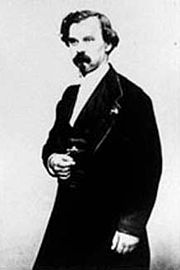
Jules Antoine Lissajous
Encyclopedia

Versailles
Versailles , a city renowned for its château, the Palace of Versailles, was the de facto capital of the kingdom of France for over a century, from 1682 to 1789. It is now a wealthy suburb of Paris and remains an important administrative and judicial centre...
– June 24, 1880, Plombières-les-Bains
Plombières-les-Bains
Plombières-les-Bains is a commune in the Vosges department in Lorraine in northeastern France.Les bains refers to the hot springs in the area, whose properties were first discovered by the Romans...
) was a French
France
The French Republic , The French Republic , The French Republic , (commonly known as France , is a unitary semi-presidential republic in Western Europe with several overseas territories and islands located on other continents and in the Indian, Pacific, and Atlantic oceans. Metropolitan France...
mathematician
Mathematician
A mathematician is a person whose primary area of study is the field of mathematics. Mathematicians are concerned with quantity, structure, space, and change....
, after whom Lissajous figure
Lissajous curve
In mathematics, a Lissajous curve , also known as Lissajous figure or Bowditch curve, is the graph of a system of parametric equationswhich describe complex harmonic motion...
s are named. Among other innovations, Lissajous invented the Lissajous apparatus, a device that creates the figures that bear his name. In it a beam of light is bounced off a mirror attached to a vibrating tuning fork
Tuning fork
A tuning fork is an acoustic resonator in the form of a two-pronged fork with the prongs formed from a U-shaped bar of elastic metal . It resonates at a specific constant pitch when set vibrating by striking it against a surface or with an object, and emits a pure musical tone after waiting a...
, and then reflected off a second mirror attached to a perpendicularly orientated vibrating tuning fork (usually of a different pitch
Pitch (music)
Pitch is an auditory perceptual property that allows the ordering of sounds on a frequency-related scale.Pitches are compared as "higher" and "lower" in the sense associated with musical melodies,...
, creating a specific harmonic interval), onto a wall, resulting in a Lissajous figure. This led to the invention of other apparatus such as the harmonograph
Harmonograph
A harmonograph is a mechanical apparatus that employs pendulums to create a geometric image. The drawings created typically are Lissajous curves, or related drawings of greater complexity...
.

